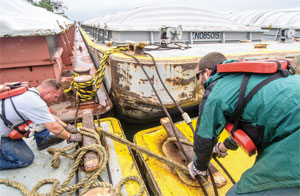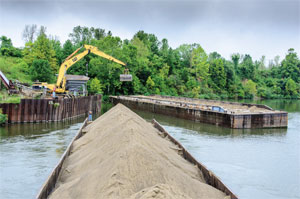Under a leaden sky and in a light drizzle, the crew aboard the 50-foot fleet boat Jacob Lane was shifting barges at the MVBS Jeffersonville fleet in Nugent Harbor, a bight with a narrow entrance cut out of the Indiana bank of the Ohio River, across from Louisville, Ky.
“I feel we have the safest harbor on the Ohio River because we have 59 acres of slack water protected by land,” said Charles Latham, general manager of MVBS Jeffersonville, a subsidiary of TPG Marine of Indianapolis. “We call it ‘the hole.’”
The vessel was only recently renamed Jacob Lane and still had its previous name, Megan Elizabeth, painted on its hull. Normally Jacob Lane would be employed by Walsh Construction, building the Highway 265 East End Bridge spanning the Ohio between Kentucky and Indiana. But because MVBS is a growing fleeting and barge service company operating on a busy stretch of the river, the boats work many and varied jobs, when and where they are needed.
 |
|
Bryn Miller, piloting Jacob Lane, moves a barge loaded with sand from an Ohio River fleet. |
“We having a working relationship with Walsh that pretty much makes them the No. 1 job when they call,” said Latham. “During spurts, we are down there working on the bridge every day.”
Mint juleps and Churchill Downs aside, a major reason UPS established Louisville as its Worldport hub is because of the rail and highway system connecting the river city to Pittsburgh, Chicago, Nashville, Atlanta, St. Louis and beyond. The plethora of 18-wheelers crowding the highways surrounding Louisville proves the point.
Most of the major river transportation companies in the country are continually churning barge tows on the Ohio that feed the Louisville/Jeffersonville intermodal network, and intermodal transportation is a major focus with TPG Marine.
“We’re a bit of a melting pot,” said Latham. “We handle all the grains, wheat, soybeans, corn, coal, scrap, steel coil and plate, ferro alloys, salt, pet coke and fertilizers of all types. We’re a melting pot in the Jeffersonville Harbor because of the location’s docks and terminal facilities on both sides of the river. We are at the crossroads of America for intermodal transportation.”
 |
|
Fleet boat Jacob Lane moves a barge, containing a deck winch, on the Indiana side of the Ohio River at the MVBS Jeffersonville fleeting site. |
In 2004, Don Miller and Dan Altman formed TPG Marine Enterprises and bought Mt. Vernon Barge Service at Mount Vernon, Ind., in 2007. Mt. Vernon Barge Service was founded by river legend Art Bayer in 1962. At the time of purchase it was a one-location company, but it had the only full-service dry docks between mile 606 and mile 846 on the Ohio River.
When Miller and Altman purchased Mt. Vernon Barge Service, the company had four boats and 38 employees. Since then, TPG has added the Jeffersonville operation with a capacity for 118 barges and Green River Barge Service with a capacity for 150 barges at Green River, Ky. At its Mount Vernon and nearby Uniontown, Ky., facilities, TPG can fleet 569 barges. The company currently owns 16 vessels and has 170 employees for all four locations.
“The Mount Vernon operation is equipped with two dry docks and is capable of total repair service,” said Latham. “Here at Jeffersonville, we can do topside repairs. But all the facilities provide barge cleaning.”
As the company’s website boasts: “We are bullish on the potential and the intent of the U.S. inland waterways: responsible, efficient, environmentally efficient commercial transportation delivered through safe, family wage jobs.”
 |
|
Deck hands Leo Stein, foreground, and Tony Hentrup hook up a fleet of barges to a shore mooring line. |
TPG has interests in terminals on the Ohio, Green and Illinois rivers and consults on intermodal transportation at those terminals. It has a software company that has developed a Harbor Management System.
The Jeffersonville operation runs two fleet boats, the 51-foot, 800-hp Jacob Lane, and the 70-foot, 1,200-hp W.J. Bayer — plus the trackable, 660-hp tug Mombo. There are four fleets in and outside the hole, and fleeting for all manner of companies, including Ingram CCI and ADM-Artco.
Latham, after 17 years with ACL as fleet manager and systems planner among other assignments, joined TPG Marine as general manager of the MVBS Jeffersonville operation five years ago. Latham spent the first year getting the fleeting permits and setting up the operation in the hole.
“I’m the safety guy,” said Josh Williams as he entered Latham’s office. As the field safety and compliance supervisor for the TPG companies, Williams oversees the company’s industry compliance as a member of the American Waterways Operators’ Responsible Carrier Program (RCP).
 |
|
Hentrup tightens up the fleet barges. |
“We have a custom safety management system (SMS) with RCP that is based on industry-wide best practices,” said Williams. He favors universal safety management systems within the industry because it would put all of the marine operating companies on an equal footing. “The biggest aspect of an SMS for us is to make sure that everything is well-documented,” he said.
Vessel manning is one of the major issues facing tugboat operators whenever the Subchapter M regulations are finally implemented. The current practice at MVBS is to have two deck hands and a pilot on every fleet boat. Williams explained that the company doesn’t have much of a problem manning the boats, but the repair division struggles to recruit welders.
Back in the hole, a nifty barge switching operation was in progress. Bryn Miller, at the helm of the fleet boat Jacob Lane, was pushing a sand barge from the fleet, across the breadth of the hole, to an excavator perched like a mechanized heron on a deck barge at Nugent Sand Company’s yard.
As Miller’s tow approached the excavator, the machine operator nudged an empty sand barge away with the machine’s shovel, floating it clear of the area. Miller moved the load in under the shovel’s yawning steel jaws and the machine operator bit into the peak of a sand hill. Miller’s deck hands, Tony Hentrup and Leo Stein, released the face wires on the load and the operator pulled the barge alongside with the evacuator and began gobbling on the sand hills, moving the barge with the shovel as needed.
Miller faced up to the empty barge and the deck hands rigged the face wires and the tow was moved back to the fleet. “We do this twice a day,” said Miller, as he swung the tug around and out through the 120-foot opening, linking the hole to the main stream of the Ohio.
 |
|
John Payne and Stein are busy breaking out a barge to be picked up by a line haul boat. |
Out on the river, Miller maneuvered Jacob Lane over to a fleet moored to the bank, and faced the fleet boat up to the stern of the outside row of barges. The deck hands attached the face wires, jumped aboard the barge and began moving forward, letting go the leave-in wires cavel-by-cavel (or cleat-by-cleat in standardized nomenclature) that secured the row of barges to the fleet. Their target was an Ingram hopper barge loaded with potash, three barges along.
Releasing the leave-in lines, wielding heavy and unruly wire cable and schlepping big steel ratchets used to tension the leave-in lines, is heavy work. With the barges free of the fleet, Miller maneuvered the tow forward. Hentrup and Stein took a few minutes break at the bow of the tow, a quiet place for the moment. After a few minutes they would be making the barges back up to the fleet.
“We’re clearing the barge out for a line haul boat coming to pick it up,” said Miller. “The grain season is about to start. That’s when we get really busy.”
Back at the office, Latham explained that MVBS’ workload is consistent from day to day. “We are pretty constant in terms of business and the diversity of our daily action plans,” he said. “However, within the next couple of weeks a potential record harvest will really keep us rockin’.”

